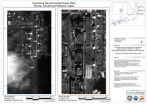(Press-News.org) FLAGSTAFF, Ariz. — Temperature increases resulting from climate change in the Southwest will likely eliminate Joshua trees from 90 percent of their current range in 60 to 90 years, according to a new study led by U.S. Geological Survey ecologist Ken Cole.
The research team used models of future climate, an analysis of the climatic tolerances of the species in its current range, and the fossil record to project the future distribution of Joshua trees. The study concludes that the species could be restricted to the northernmost portion of its current range as early as the end of this century. Additionally, the ability of Joshua trees to migrate via seed dispersal to more suitable climates may be severely limited.
"This is one of the most interesting research projects of my career," said Ken Cole, a USGS ecologist and the study's lead author. "It incorporated not only state-of-the-art climate models and modern ecology, but also documentary information found in fossils that are more than 20,000 years old."
By using fossil sloth dung found in desert caves and packrat middens — basically, the garbage piles of aptly named packrats — scientists were able to reconstruct how Joshua trees responded to a sudden climate warming around 12,000 years ago that was similar to warming projections for this century. Prior to its extinction around 13,000 years ago, the Shasta ground sloth favored Joshua trees as food, and its fossilized dung contained abundant remains of Joshua trees, including whole seeds and fruits. These fossil deposits, along with fossil leaves collected and stored by packrats, allowed scientists to determine the tree's formerly broad range before the warming event.
The study concluded that the ability of Joshua trees to spread into suitable habitat following the prehistoric warming event around 12,000 years ago was limited by the extinction of large animals that had previously dispersed its seeds over large geographic areas, particularly the Shasta ground sloth. Today, Joshua tree seeds are dispersed by seed-caching rodents, such as squirrels and packrats, which cannot disperse seeds as far as large mammals. The limited ability of rodents to disperse Joshua tree seeds in combination with other factors would likely slow migration to only about 6 feet per year, not enough to keep pace with the warming climate, Cole and his colleagues concluded.
The Joshua tree, a giant North American yucca, occupies desert grasslands and shrublands of the Mojave Desert of California, Nevada, Arizona, and Utah; Joshua Tree National Park in California is named after this iconic species. The Joshua tree is known for its distinctive shape and height of up to 50 feet.
###Results of the study, "Past and ongoing shifts in Joshua tree distribution support future modeled range contraction," appear in a current edition of "Ecological Applications." The research team included Kenneth L. Cole, U.S. Geological Survey; Kirsten Ironside, Northern Arizona University; Jon Eischeid, NOAA Earth Systems Research Laboratory; Gregg Garfin, University of Arizona; Phillip B. Duffy, Lawrence Livermore National Laboratory and University of California; and Chris Toney, USDA Forest Service.
USGS provides science for a changing world. For more information, visit www.usgs.gov. Subscribe to USGS News Releases via our RSS feed.
Uncertain future for Joshua trees projected with climate change
2011-03-25
ELSE PRESS RELEASES FROM THIS DATE:
Inclusion of falls history shown to enhance accuracy of fracture risk assessment models
2011-03-25
Researchers from the MRC Lifecourse Epidemiology Unit in Southampton, UK, have presented a new study that shows how the inclusion of falls history, in addition to clinical risk factors (CRFs) and bone mineral density (BMD) values, would greatly improve the accuracy of fracture prediction models. The research findings were presented today at the European Congress on Osteoporosis & Osteoarthritis in Valencia, Spain.
Using results from the Hertfordshire Cohort Study, the investigators examined the relative contributions of CRFs, BMD and falls history to fracture prediction. ...
RIT researchers help map tsunami and earthquake damage in Japan
2011-03-25
Japan needs maps. Not just any kind—detailed informational maps georegistered with latitude and longitude and annotated with simple, self-evident details: this bridge is out, this port is damaged, this farm field is scoured; this one is verdant.
Researchers at Rochester Institute of Technology are processing satellite imagery of regions in Japan affected by the 9.0 magnitude earthquake and tsunami that devastated sections of the country's east coast on March 11. The U.S. Geological Survey, a member of the International Charter "Space and Major Disasters," organized the ...
Changing Misconceptions About Immigration
2011-03-25
When French president Nicolas Sarkozy recently declared that France's efforts at "multiculturalism" were a failure, it reminded those of us in the United States that we're not the only country in the world grappling with issues related to foreign immigration. But while European countries have tended to focus on the cultural side of the immigration debate, Americans are often focused on the perceived economic problems of immigration. As it turns out, Americans have less to worry about on both fronts than the current rhetoric might lead one to believe.
Economically, immigrants ...
Study: Teachers unaware of growing gender gaps in classrooms
2011-03-25
CHAMPAIGN, Ill. – A gap in reading and math scores still exists in lower grades, with boys continuing to outpace girls in math, and girls ahead of boys in reading, two University of Illinois education professors say.
Using national longitudinal data to perform their analysis, Joseph P. Robinson and Sarah Lubienski investigated male and female achievement in math and reading, looking for when gender gaps first appeared and where in the distribution the gaps were most prevalent.
Except for kindergarteners in the 99th percentile, boys and girls generally start out on equal ...
ATVs Remain Dangerous and Prone to Accidents, Crashes
2011-03-25
A recent death of a 12 year old in Florida highlights the danger inherent in the operation of All Terrain Vehicles (ATVs). Since their introduction in the early 1980s, ATVs have resulted in thousands of deaths and hundreds of thousands of emergency room visits.
While the designs have changed from the original 3-wheel, tricycle layout of the first Honda ATV, what hasn't changed is the danger posed by using these recreational vehicles. Since 1982, Florida has reported 447 deaths in connection with ATVs.
Nationwide, in the same period, at least 10,000 people have died ...
Around 25 percent of health messages in Spanish text books are not based on scientific evidence
2011-03-25
Most school text books contain messages about health, but 24.6% of these are not based on any scientific evidence, according to a study by the Knowledge Management Unit at Baza Hospital (Granada), published in the journal BMC Public Health.
"We analysed a total of 844 health messages in primary and secondary school text books in order to identify the level of scientific evidence underpinning these texts, and we classified them into three categories – messages with a high, medium or low level of evidence, messages with an unknown level of evidence, and messages with no ...
A Motorcycle Helmet: Use It or Lose It?
2011-03-25
The National Transportation Safety Board (NTSB) recently issued a press release putting mandatory motorcycle helmet use on its Most Wanted List of Transportation Safety Improvements.
It reported that from 1997 through 2008, the number of motorcycle fatalities more than doubled during a period when overall highway fatalities declined
The NTSB has recommended that everyone riding a motorcycle be required to wear a helmet. Currently, only 20 states, the District of Columbia and four territories have universal helmet laws that apply to all riders.
Twenty-seven states ...
Atlanta Airport Hotel Offers Nearby Lodging to Travelers Visiting Fernbank NatureQuest
2011-03-25
The Hampton Inn & Suites Atlanta Airport Hotel (North I-85) offers nearby accommodations to travelers planning to visit the Fernbank Museum of Natural History near midtown Atlanta. The Museum recently launched a new permanent exhibition, Fernbank NatureQuest. Guests can climb trees and cross rope bridges to a working clubhouse, which sits atop giant trees. Tickets for Fernbank NatureQuest are included with Museum admission and free for all members.
Fernbank's other permanent exhibitions include:
- Dinosaur Entrance Plaza
- Giants of the Mesozoic
- A Walk through Time ...
BrainGate neural interface system reaches 1,000-day performance milestone
2011-03-25
PROVIDENCE, R.I. [Brown University] — Demonstrating an important milestone for the longevity and utility of implanted brain-computer interfaces, a woman with tetraplegia using the investigational BrainGate* system continued to control a computer cursor accurately through neural activity alone more than 1,000 days after receiving the BrainGate implant, according to a team of physicians, scientists, and engineers developing and testing the technology at Brown University, the Providence VA Medical Center, and Massachusetts General Hospital (MGH). Results from five consecutive ...
Against the tide: Currents keep dolphins apart
2011-03-25
Conservationists from the Wildlife Conservation Society, the American Museum of Natural History, and other conservation and research groups have discovered that groups of dolphins in the western Indian Ocean do not mix freely with one another. In fact, dolphin populations are kept separate by currents and other unseen factors.
Specifically, the researchers have found that genetically distinct populations of the Indo-Pacific humpback dolphin may be formed in part by currents, surface temperature differences, and other environmental barriers, a finding made possible by ...



